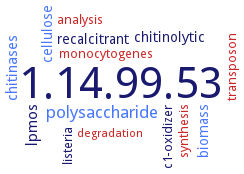1.14.99.53: lytic chitin monooxygenase
This is an abbreviated version!
For detailed information about lytic chitin monooxygenase, go to the full flat file.

Word Map on EC 1.14.99.53 
-
1.14.99.53
-
polysaccharide
-
chitinases
-
lpmos
-
recalcitrant
-
chitinolytic
-
cellulose
-
biomass
-
c1-oxidizer
-
analysis
-
synthesis
-
listeria
-
transposon
-
monocytogenes
-
degradation
- 1.14.99.53
- polysaccharide
- chitinases
-
lpmos
-
recalcitrant
-
chitinolytic
- cellulose
- biomass
-
c1-oxidizer
- analysis
- synthesis
-
listeria
- transposon
- monocytogenes
- degradation
Reaction
Synonyms
AA10, AA10A, AA9A, AO090102000501, BATR1942_08650, BURPS1710b_0114, CBM33A, CBP21, Cbp33A, CelS2, chitin-binding domain 3 protein, EF_0362, G15G9.090, GbpA, Jden_1381, lmo2467, LPMO10, LPMO10A, LPMO10B, LPMO10F, Micau_1630, PMO-2, RBAM17540, SCO0643, SGR_6855
ECTree
Advanced search results
Crystallization
Crystallization on EC 1.14.99.53 - lytic chitin monooxygenase
Please wait a moment until all data is loaded. This message will disappear when all data is loaded.
in presence of Zn2+, to 1.55 A resolution, and in presence of Cu2+, to 1.4 AS resolution
comparative analysis of sequences, solved structures, and homology models from AA9 and AA10 LPMO families.The two LPMO families are highly conserved, structurally they have minimal sequence similarity outside the active site residues
to 1.85 A resolution, tri-modular enzyme containing a catalytic family AA10 LPMO module, a family 5 chitin-binding module, and a C-terminal unclassified module which displays tight and specific binding to chitin
comparative analysis of sequences, solved structures, and homology models from AA9 and AA10 LPMO families.The two LPMO families are highly conserved, structurally they have minimal sequence similarity outside the active site residues
crystal structure in the Cu(II)-bound form and photoreduction of the crystalline protein in the x-ray beam, leading to conversion from the initial Cu(II)-oxidized form with two coordinated water molecules, which adopts a trigonal bipyramidal geometry, to a reduced Cu(I) form in a T-shaped geometry with no coordinated water molecules
1.1 A resolution room-temperature X-ray structure and 2.1 A resolution neutron structure, show a putative dioxygen species equatorially bound to the active site copper with elongated density for the dioxygen, most consistent with a Cu(II)-bound peroxide
1.1 A resolution, room-temperature X-ray structure and a 2.1 A resolution neutron structure show a putative dioxygen species equatorially bound to the active site copper. Both structures show an elongated density for the dioxygen, consistent with a Cu(II)-bound peroxide. The coordination environment is consistent with Cu(II). The N-terminal amino group, involved in copper coordination, is present as a mixed neutral and deprotonated form
1.55 A resolution structure of N-terminal LPMO10A module reveals deletions of interacting loops that protrude from the core beta-sandwich scaffold in larger LPMO10s
structure of the catalytic domain, residues 37-230, to 1.08 A resolution. The active site in is formed by residues His-37 and His-144 that coordinate the copper atom in a T-shaped geometry
structures in the resting state and of a copper(II)-dioxo intermediate complex formed in the absence of substrate reveal pre-bound molecular oxygen adjacent to the active site. A conserved histidine is involved in promoting oxygen activation
to 1.2 A resolution. Diffraction resolution and crystal morphology are improved by expression from a glycoengineered strain of Pichia pastoris
crystallization at pH 3.5. Structure shows shows significant disorder of the active site in the absence of substrate ligand
calculation of solution structure. Ca2+, Mg2+, Fe3+, Co2+, Zn2+, or Cu2+ ions show binding to an interaction site located between His28 and His114
molecular dynamics interactions between the LPMO and three different surface topologies of crystalline chitin. Most enzyme-substrate interactions involve the polysaccharide chain that is to be cleaved. Enzyme displays a constrained active site geometry as well as a tunnel connecting the bulk solvent to the copper site, through which only small molecules such as H2O, O2, and H2O2 can diffuse. Rearrangement of Cu-coordinating water molecules is necessary when binding the substrate and also provide a rationale for the experimentally observed C1 oxidative regiospecificity
structure of the catalytic domain, residues 37-230, to 1.08 A resolution. The active site in is formed by residues His-37 and His-144 that coordinate the copper atom in a T-shaped geometry


 results (
results ( results (
results ( top
top





